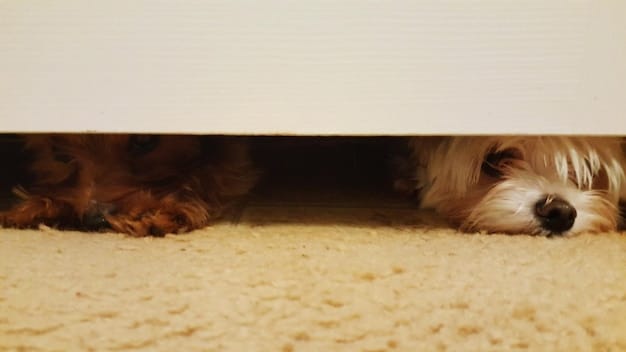Separation Anxiety in Dogs: A Step-by-Step Guide for US Owners

Separation anxiety in dogs manifests as distress when left alone and can be managed through gradual training, creating a safe environment, and sometimes with the help of a veterinarian or certified dog trainer, offering a better quality of life for both the dog and owner.
Does your furry friend become agitated, destructive, or excessively vocal when you leave the house? They might be experiencing separation anxiety in your dog. Learning to identify and manage this condition can significantly improve your dog’s well-being and strengthen your bond.
Understanding Canine Separation Anxiety
Understanding the reasons behind separation anxiety is crucial. This isn’t simply a case of a dog being “naughty” while you’re away; it’s a genuine distress response rooted in fear and uncertainty.
The triggers, symptoms, and management strategies can vary from dog to dog, requiring a personalized approach. Let’s delve into the underlying causes and how they manifest.
What Causes Separation Anxiety?
Several factors can contribute to separation anxiety. These can range from sudden changes in routine to deeper-seated emotional insecurities.
It is also important to consider that there is a genetic component to anxiety in dogs. Some breeds are, by nature, more prone to anxiety than other dogs. It is important to keep this in mind when adopting or purchasing a dog from a breeder.
- Change in Routine: A new work schedule, a move to a different home, or even a slight alteration in your daily habits can trigger anxiety.
- Loss of a Family Member: The absence of a human or animal companion can leave a dog feeling vulnerable and alone.
- Early Life Experiences: Puppies who were separated from their mothers too early or experienced instability in their early homes may be more susceptible.
- Medical Conditions: In some cases, underlying medical issues can contribute to anxiety-related behaviors. Always rule out medical causes with your vet.

Recognizing the Symptoms
Identifying the symptoms of separation anxiety is the first step toward helping your dog. The signs can range from subtle to dramatic.
It is also important to realize that sometimes these symptoms can be disguised. A dog may be destructive in a way that appears to be accidental, when it is actually meant to be attention-seeking or to communicate its anxiety over isolation.
- Destructive Behavior: Chewing furniture, scratching doors, or destroying personal items are common outlets for anxiety.
- Excessive Vocalization: Constant barking, howling, or whining can signal distress.
- Inappropriate Elimination: Urinating or defecating inside, even if housetrained, can be a sign.
- Pacing and Restlessness: Unexplained agitation and an inability to settle down can indicate anxiety.
In conclusion, understanding the causes and recognizing the symptoms are vital first steps in managing separation anxiety. Identifying the root of the issue helps tailor effective strategies to alleviate your dog’s distress.
Creating a Safe and Predictable Environment
A secure and predictable environment is essential for a dog with separation anxiety. It provides a sense of stability and reduces the unknown factor that can trigger anxiety.
Think of your house as your dog’s castle. It should be a place that he/she feels the can retreat to feel comforted and protected.
The Importance of a Routine
A consistent daily routine can significantly reduce anxiety. Dogs thrive on predictability.
Try to stick to a schedule for feeding times, walks, playtimes and sleeping times. A predictable rhythm to the day will comfort the dog and decrease anxiety.
However, be sure to vary the activities included in playtime, and the sights and smells of the route you walk. This way you are introducing new stimuli so that the dog stays curious and excited.
Making Your Home a Comfort Zone
Create a safe haven for your dog with familiar items and comforting scents.
Consider leaving a radio or television on, set to a talk station. This will simulate the presence of a human voice and ease anxiety.
- Designated Safe Space: Provide a crate, bed, or quiet corner where your dog can retreat when feeling anxious.
- Familiar Scents: Leave an unwashed t-shirt or blanket with your scent in their safe space.
- Calming Aids: Consider using anxiety-reducing pheromone diffusers or sprays, such as those containing dog-appeasing pheromones.
To summarize, a safe and predictable environment is the cornerstone of managing separation anxiety. Routine and comfort are your allies in easing your dog’s distress.
Gradual Desensitization and Counterconditioning
Gradual desensitization and counterconditioning are proven techniques for reducing separation anxiety. These involve slowly exposing your dog to triggers and associating them with positive experiences.
Remember that patience is key in this situation, so don’t rush the process or it may backfire.
Desensitization to Departure Cues
Desensitize your dog to the cues that signal your departure, like picking up keys or putting on shoes.
Pick up your keys, then put them back down. Put on your shoes, then take them off. This will break the dog’s association between those activities and your departure.
Don’t do these departure cues only when leaving. Go through this departure ritual, and then stay home.
Counterconditioning with Positive Associations
Associate your departure with something positive, like a special treat or toy.
Give the dog a valuable treat right before leaving the house. Make it a treat or toy that the dog enjoys more than other items. But be sure to only do this right before leaving.
- Puzzle Toys: Offer a puzzle toy filled with treats just before you leave.
- Special Chews: Provide a long-lasting chew that will keep them occupied during your absence.
- Scent Games: Hide treats around the room for them to find while you’re gone.

In essence, gradual desensitization and counterconditioning are powerful tools. They help change your dog’s emotional response to being alone by associating it with positive experiences and diminishing the fear associated with departure cues.
Training Techniques to Build Confidence
Building your dog’s confidence through specific training techniques can help alleviate separation anxiety. A confident dog is less likely to feel vulnerable when left alone.
In this case it will benefit dogs to get some of their energy out beforehand, so that they are not bursting at the seams to play while alone at home.
Basic Obedience Training
Strengthen the bond with your dog through basic obedience commands like “sit,” “stay,” and “come.”
Enroll them in a class or watch videos online and get some tips for how to train your dog. This is a fun family or individual activity for dog lovers and can result in greater peace in the house.
Basic obedience training not only builds communication but also provides mental stimulation, which is essential for a dog’s overall well-being.
Mental Stimulation Exercises
Engage your dog in activities that challenge their mind and keep them entertained.
Be sure to take them outside to play, go to the dog park or dog beach, and get your dog into nature as much as possible. This will wear them out and relax them.
- Puzzle Toys: Invest in interactive puzzle toys that require your dog to solve problems to get treats.
- Scent Work: Train your dog to find hidden scents, which is mentally stimulating and builds confidence.
- Agility Training: Agility courses can provide a physical and mental workout, boosting confidence and reducing anxiety.
In summary, building confidence is key to alleviating separation anxiety. Training techniques like basic obedience and mental stimulation exercises empower your dog and reduce their dependence on your presence.
When to Seek Professional Help
While many cases of separation anxiety can be managed with home-based strategies, sometimes professional intervention is necessary. Recognizing when to seek help is crucial for your dog’s well-being.
Not all anxiety in dogs and other pets can safely be handled by their owners. Sometimes a professional is required.
Consulting a Veterinarian
Your veterinarian can rule out underlying medical conditions and recommend appropriate treatment options.
The veterinarian may recommend that your dog see a specialist in dog anxiety if he or she thinks that is necessary.
The specialist can give more targeted advice and training strategies based on the particular characteristics of your dog.
Working with a Certified Dog Trainer or Behaviorist
A professional dog trainer or behaviorist can provide tailored guidance and support.
Be careful to choose a trainer who is sensitive to your dog and seems genuinely interested in his or her well-being.
- Personalized Training Plans: A trainer can create a customized plan based on your dog’s specific needs and triggers.
- Behavior Modification Techniques: They can teach you techniques to change your dog’s anxious behaviors.
- Ongoing Support: A behaviorist can provide ongoing support and guidance throughout the treatment process.
In essence, recognizing when to seek professional help is vital for your dog’s well-being. Veterinarians, trainers, and behaviorists offer valuable expertise and support to address severe cases of separation anxiety effectively.
Medication and Alternative Therapies
In some cases, medication and alternative therapies can be valuable tools in managing separation anxiety. These options should be considered in consultation with your veterinarian.
It is often best practice not to give a pet medication for anxiety unless non-medical interventions have failed previously.
Medication Options
Certain medications can help reduce anxiety in dogs, but they should always be prescribed and monitored by a veterinarian.
Medication can address underlying biochemical imbalances that may contribute to the pet’s anxious state.
- Anti-Anxiety Medications: Medications like fluoxetine or clomipramine can help alleviate anxiety symptoms.
- Short-Acting Sedatives: In some cases, short-acting sedatives may be used to help dogs cope with specific stressful situations.
Alternative Therapies
Natural remedies and therapies can complement traditional treatment methods.
More and more people are turning to natural remedies for their pets as they themselves pursue holistic treatments and medicines.
- Herbal Remedies: Herbs like chamomile, valerian root, and lavender have calming properties.
- Acupuncture: Acupuncture may help reduce anxiety by promoting relaxation and balancing energy flow.
- Massage Therapy: Gentle massage can help relieve tension and promote relaxation.
To summarize, medication and alternative therapies can play a significant role in managing separation anxiety. Medication should be used under veterinary supervision, while alternative therapies can complement traditional treatments to provide holistic support for your dog.
| Key Point | Brief Description |
|---|---|
| 🏠 Safe Environment | Create a secure and comforting space for your dog. |
| 🐾 Gradual Training | Slowly desensitize your dog to departure cues. |
| 💊 Medication Support | Consult your vet about medication options if needed. |
| 🐕🦺Professional Help | Seek advice from trainers or behaviorists. |
Frequently Asked Questions
▼
Key signs include destructive behavior, excessive barking or howling, inappropriate urination or defecation, pacing, and attempts to escape. These behaviors typically occur when the dog is left alone.
▼
Designate a quiet area with familiar items like a bed, toys, and clothing with your scent. Make it a comfortable retreat where your dog feels secure.
▼
It involves slowly exposing your dog to departure cues without actually leaving. This helps reduce the anticipation and anxiety associated with these triggers.
▼
Consult a vet or behaviorist if symptoms are severe, persist despite home management, or if your dog’s distress is causing significant disruptions.
▼
Medication can help manage symptoms, but it is most effective when combined with behavioral therapies and environmental management. It is important to view it as part of a comprehensive treatment plan.
Conclusion
Managing separation anxiety in dogs requires patience, consistency, and sometimes professional help. By understanding the causes, creating a safe environment, and applying gradual training techniques, you can significantly improve your dog’s well-being and strengthen your bond. Remember, every dog is different, so finding the right approach may take time and experimentation.





